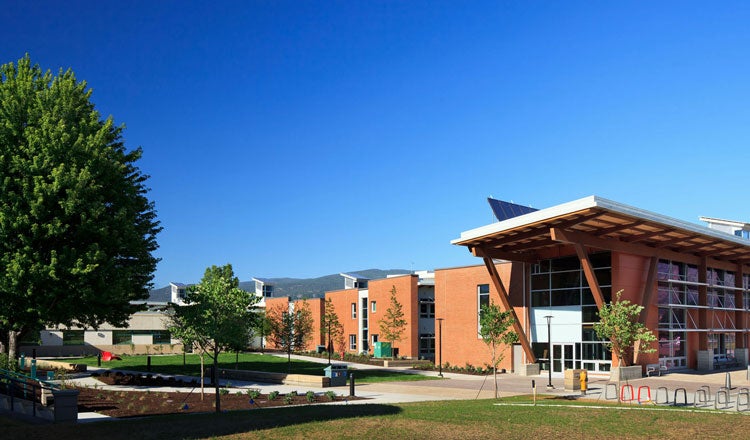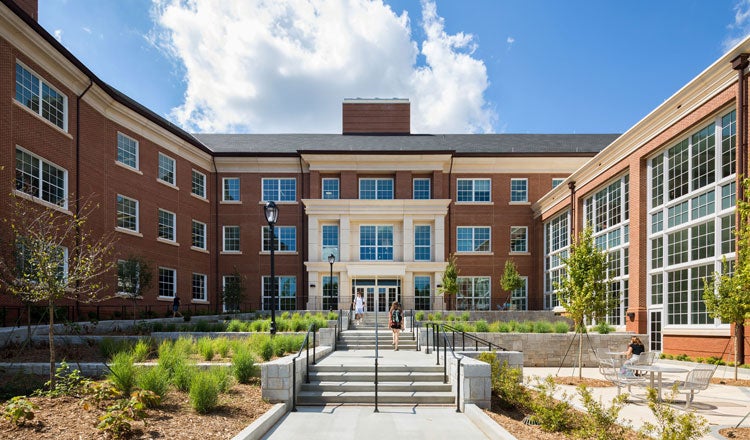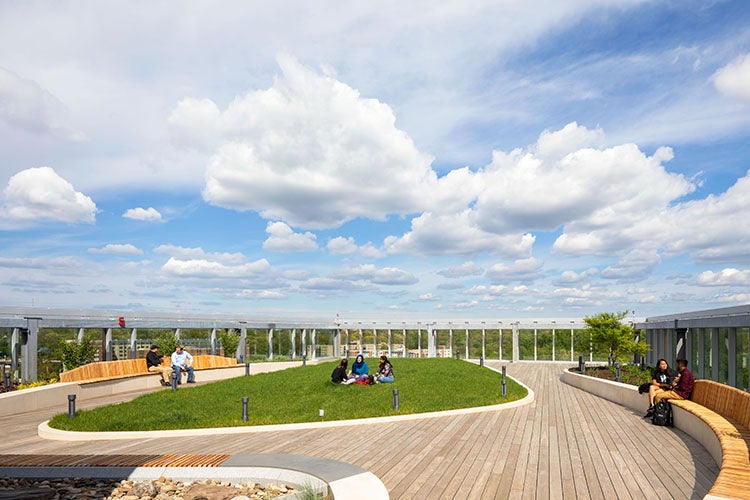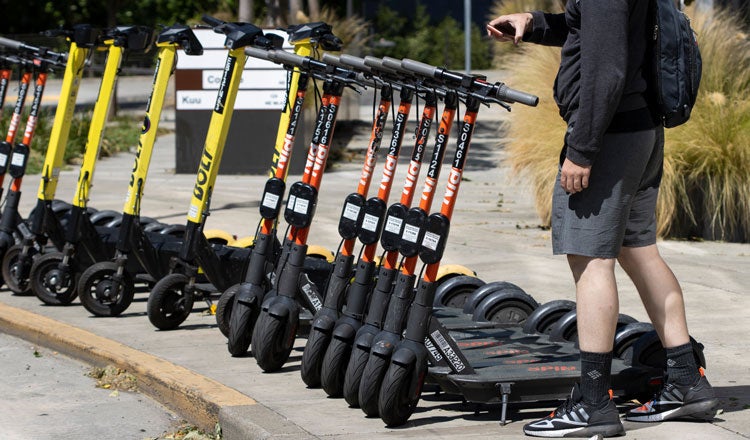
5 Essential Roles for Landscape in Campus Design
When you think of a typical college campus, you might imagine groups of backpack-laden students making their way through the central quad, sprawling books and computers on campus lawns and stopping to mingle on the mall. While campus landscapes often evoke this type of idyllic, carefree imagery, they are also working hard to support students and staff. Landscapes serve numerous functional purposes in campus planning, and as academia adapts to shifting societal norms and environmental imperatives, these functions are evolving, further emphasizing the essential roles that landscape can play on today’s campus.

1. Landscape as Sustainability Catalyst
Back when LEED was new, universities were able to get a lot of prestige from achieving LEED certification. Today, it is less the exception and more the norm, and many institutions are realizing they need to move beyond systems that focus on simply doing less harm and are prioritizing net zero and regenerative campus design goals. Perhaps not surprisingly, landscapes are perfect candidates for supporting these environmental initiatives and backing them up with research.
Many traditional landscape elements are extremely functional from an environmental perspective. Design elements such as shelter belts and tree canopy shading have made significant contributions to sustainability, and healthy plants and soil are one of the most effective and cost-efficient ways of sequestering carbon. For example, six full-size trees will remove approximately 1 ton of carbon dioxide from the air, and 18 inches of planting soil will increase the soil water storage capacity by 31.9%.

While scenic campus landscapes contribute to the financial success of institutions by attracting prospective students and their parents, investors and donors, not all landscapes are created equal. Some traditional and idyllic campus features, such as large lawn areas, consume a lot of resources. To confront budget challenges, campus landscape value can be increased and its burden minimized by putting them to work and layering in multiple performative functions.
The right time to consider incorporating these ideas is at the point of site selection, programming and budgeting. In areas where local storm infrastructure capacity is very limited, using landscape can help limit a new project’s impact on those networks and offset costs. At the University of Georgia, HDR landscape architects developed a plaza that functions as a “living room” for a new Science Learning Center, where students and faculty can meet and exchange ideas. The site also functions as part of a stormwater treatment train for surface, HVAC and roof runoff that integrates the new building with its neo-Georgian surroundings.

2. Landscape as Wellness Driver
Similarly, wellness is a hot topic and a key priority on many campuses right now. Much of this is a response to the staggering numbers of students who, according to the American College Health Association report published in Fall 2022, have stated that anxiety (31.7%), depression (23.2%), sleep difficulties (22.1%) and stress (38.0%) have affected their academic performance in the last year. Landscapes are the perfect candidate to support these efforts by providing respite and an environment for interaction away from technology on campus.
In this era of increased focus on mental health and recognition of neurodivergence, awareness of more divergent needs should impact the way space is allocated. While many campuses have a plethora of large open spaces, often missing are smaller or less-active spaces that can provide moments of quiet, respite and even solitude vital to different levels of interaction and mental health.
At the University of Colorado Boulder’s Caruthers Biotechnology Building, our team designed two courtyard spaces that connect the building site to its campus context and facilitate varying levels of interaction. One courtyard space is focused on student discourse and engagement, offering a variety of seating and tables, Wi-Fi and charging stations, while the second courtyard is designed to be more contemplative, with seat walls and various calming features, such as a native landscape design that naturally filters stormwater and views toward the mountains.
Another successful example of a smaller-scale outdoor space on campus is the rooftop park on top of the Brendan Iribe Center for Computer Science and Engineering, which offers stunning views of campus with space to sit, walk, study and mingle with friends in a relatively quiet setting with a mix of hard and soft surfaces for different types of interaction.

3. Landscape as Technology Integrator
Over the past decade, rapid technological innovation has greatly influenced how we use indoor and outdoor spaces. While technology-based mixed-reality activities (think Pokémon Go) that absorbed people’s attention by bringing virtual and real worlds together while enjoying outdoor space have come and gone over the years, the mere prevalence of smartphones has caused people to regularly lose awareness of their surroundings in public spaces. This era of technology has impacted human behavior and created the need for public spaces to be flexible and adapt to sudden and unpredictable shifts.
A similar rapid evolution in technology is changing the world of transportation. We have already seen the extensive impact of ridesharing, on-demand delivery and bike-sharing, which is changing how people use campuses. Cities and campuses need to consider “curb management” strategies, including whether drop-off zones are placed or sized correctly for today’s needs, where vehicles should be excluded or admitted and how much space to allocate to parking.
The Denver region Mobility Choice Blueprint demonstrates this approach. It outlines programs to guide the integration of new kinds of transportation, including self-driving vehicles and suggests public-private policies to demonstrate concepts and find joint sources of funding.
It’s clear that technology is driving an entirely new set of uses in the campus landscape, and these must be accounted for in campus design and planning efforts as institutions continue to highlight their priorities. Campuses often operate as independent entities both within and separate from the urban and rural areas that surround them and need to take approaches that work for their internal needs while responding to these larger strategies.
4. Landscape as Data Source
Increased use of technology goes hand-in-hand with increased access to more data, sometimes in real time. Academic institutions have been evolving their own approaches to institutional data over the last decade and embedding it into their decision-making processes. At HDR, our campus master planning efforts regularly leverage institutional data and our data-driven design team has created specific tools that allow us and our clients to visualize data in 3D or drill down into detailed information during the planning process.
Several institutions are leading the way. Michigan State University’s Infrastructure Planning and Facilities Department has streamlined its landscape maintenance services by using GIS technology and real-time data to create more efficient, data-driven operations, allowing maintenance crews to record and see a map of their progress and ultimately improve their sustainability efforts.
We applied a similar approach to our work on The Cyber Center of Excellence, where we developed a dashboard to help the design team and client select different potential landscape types for the campus based on their initial cost, maintenance and environmental benefits.
The ability to effectively track activity, maintenance costs, energy usage and more will only grow in importance as more campus design efforts fully leverage the capabilities and insights provided by data analytics.
5. Landscape as Network Mortar
Landscapes have always been the “glue”— critical to connecting places on campus. But just as the nature of what constitutes a “traditional” student is no longer as clear as it once was, what constitutes a “traditional” campus has also changed in recent years. Technology, online courses, lifelong learning, industry partnerships and a shift towards problem-based curricula have blurred the lines between city and campus. Students can learn anytime, anywhere — creating a vast educational environment that can, at times, be a challenge to navigate.
While the pandemic caused a shift to more virtual-based learning, it became clear that students still crave and treasure in-person learning and interaction, which emphasizes the value of in-person connection that virtual learning cannot replace. With this in mind, it is vital for campuses to prioritize the establishment of spaces that not only encourage socializing and communal learning but also promote safety and well-being.
As the dynamic nature of the above trends indicates, the human relationship to landscape is ever-changing. The ways in which we can use landscape to promote environmental stewardship, student and faculty wellness and better learning outcomes are always evolving and further emphasize the need to take a more holistic view of campuses. This pace of change in academia is simultaneously challenging and exciting from a campus design and planning perspective.

